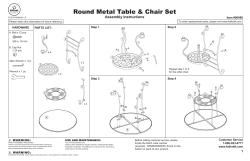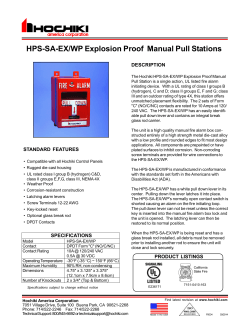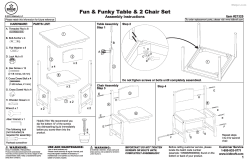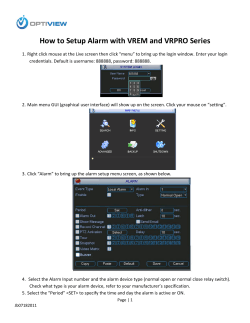
RA-1000 Series Remote Multiplex Annunciator Panels Installation and Wiring Manual LT-617 Rev. 17
RA-1000 Series Remote Multiplex Annunciator Panels Installation and Wiring Manual LT-617 Rev. 17 July 2014 1.0 Introduction 5 1.1 Contact Us ..................................................................................................................... 6 1.1.1 General Inquiries ............................................................................................................ 6 1.1.2 Customer Service .......................................................................................................... 6 1.1.3 Technical Support .......................................................................................................... 6 1.1.4 Website .......................................................................................................................... 6 2.0 Mechanical Installation 7 3.0 Wiring Instructions 8 3.1 RS-485 WIRING ............................................................................................................ 8 3.2 24V DC POWER WIRING ............................................................................................. 8 4.0 DIP Switch Settings 4.1 The DIP switches (located on the main) are set as: ...................................................... 9 4.2 For FA-1000, FA-200, SFC-308, and MR-2300 Series Panels ...................................... 9 4.3 For FX-2000 Panels ....................................................................................................... 10 4.4 For FleX-Net and MMX Panels ...................................................................................... 10 4.5 For FX-3500, FX-3500RCU, FX-350, FA-300, FR-320, and MR-2350 Panels .............. 11 4.6 The RAX-1048/TZ/TZDS Adder Annunciator Chassis ................................................... 11 4.7 The RAM-1032/TZ/TZDS Main Annunciator Chassis .................................................... 11 4.8 The RAM-1016/TZ/TZDS Main Annunciator Chassis .................................................... 11 5.0 Specifications and Features 5.1 Enclosures ..................................................................................................................... 13 5.2 Annunciators .................................................................................................................. 13 5.2.1 RAM-1032/TZ/TZDS Main Annunciator Chassis ........................................................... 13 5.2.2 RAM-1016/TZ/TZDS Main Annunciator Chassis ........................................................... 13 5.2.3 RAX-1048/TZ/TZDS Adder Annunciator Chassis .......................................................... 14 5.3 Current Drain for Battery Calculations ........................................................................... 14 5.4 Environmental Specifications ......................................................................................... 14 6.0 Warranty & Warning Information 9 13 15 3 4 Introduction 1.0 Introduction MGC's modular design RA-1000 Series Remote Multiplex Annunciator panels provide a large capacity of annunciation with MGC’s Analog and Network Fire Alarm Control Panels. Tables below describe the different main annunciator and adder chassis models. Each circuit indicator is a bi-colour LED that is automatically configured to match the fire alarm control panel configuration. Table 1 Annunciator Chassis Descriptions Annunciator Description Model Number RAM-1016 16-circuit main annunciator chassis RAM-1016TZ/TZDS 16-circuit main annunciator chassis with 16 added zoned trouble LEDs RAM-1032 32-circuit main annunciator chassis, expandable with adder annunciators RAM-1032TZ/TZDS 32-circuit main annunciator chassis with 32 added zoned trouble LEDs that may be expanded with up to four RAX-1048/TZ/TZDS adder annunciator chassis to a maximum of 208 circuit display points RAX-1048 48-circuit adder annunciator chassis RAX-1048TZ/TZDS 48-circuit adder annunciator chassis with 48 added zoned trouble LEDs 5 Introduction 1.1 Contact Us For General Inquiries, Customer Service and Technical Support you can contact us Monday to Friday 8:00 A.M. to 5:00 P.M. E.S.T. 1.1.1 General Inquiries Toll Free 1-888-660-4655 (North America Only) Local 905-660-4655 Email mail@mircom.com 1.1.2 Customer Service Toll Free 1-888-MIRCOM5 (North America Only) Local 905-695-3535 Toll Free Fax 1-888-660-4113 (North America Only) Local Fax 905-660-4113 Email salessupport@mircom.com 1.1.3 Technical Support Toll Free 1-888-MIRCOM5 (North America Only) 888-647-2665 International 905-647-2665 Email techsupport@mircom.com 1.1.4 Website www.mircom.com 6 Mechanical Installation 2.0 Mechanical Installation There are five sizes of enclosures available, see Table 2 below: Table 2 Enclosure Dimensions and Capacity Enclosure Model Number Height H(in.) Mounting A (in.) Mounting B (in.) Annunciator Capacity BB-1001(MMX-BB-1001) 9.0” 9.95” 7.5” 1 BB-1002(MMX-BB-1002) 18.0” 9.95” 16.5” 2 BB-1003(MMX-BB-1003) 26.5” 9.95” 24.9” 3 BB-1008(MMX-BB-1008) 33.0” 20.9” 35.2” 8 BB-1012(MMX-BB-1012) 45.0” 20.9” 52.0” 12 BACKBOX WALL DOOR BACKBOX CAN BE MOUNTED WITH STANDARD 4" X 4" ELECTRICAL BOXES 12.75" B DOOR H A 1.2" BB-1001 BACKBOX IS SHOWN #6-32 HEXNUTS ANNUNCIATOR CHASSIS Figure 1 i Mechanical Assembly Diagram Notes: The RAM-1032/TZ/TZDS and the RAM-1016/TZ/TZDS are supplied with the NP-680 laser printable label sheet. Column 1A or 1B (English or French) is selected for either a 2-stage or 1-stage system and the blank labels are used to print zone information. The RAX-1048/ TZ/TZDS is supplied with the NP-681 blank laser printable label sheet. The RA series of annunciators normally display Initiating Circuit Status (no individual circuit troubles); however, models RAM-1016TZ/DS, RAM-1032TZ/DS, and RAX-1048TZ/ DS will allow individual circuit trouble indication. Indicating and Relay Circuits are not remotely displayed. For more details, see the Fire Alarm Control Panel manual. 7 Wiring Instructions 3.0 Wiring Instructions 3.1 RS-485 WIRING Figure 2 The RS-485 wiring to the RAM-1016/TZ/TZDS and RAM-1032/TZ/TZDS Module is recommended to be twisted shielded pair as shown in Figure 2. The wire gauge may be: 3.2 • 22 AWG up to 2000 ft. • 20 AWG up to 4000 ft. Wiring Diagram + 24 VDC INPUT 24 VDC POWER FROM FIRE ALARM CONTROL PANEL OR PREVIOUS ANNUNCIATOR + 24 VDC OUTPUT 24 VDC POWER TO NEXT ANNUNCIATOR + RS-485 INPUT RS-485 FROM FIRE ALARM OR PREVIOUS ANNUNCIATOR (TWISTED SHIELDED PAIR) S - 24V DC POWER WIRING + RS-485 OUTPUT RS-485 TO NEXT ANNUNCIATOR (TWISTED SHIELDED PAIR) S - The RS-485 wiring from the fire alarm control panel to the P11 annunciator(s) must be pointto-point from the fire alarm panel to the first annunciator, then to the next annunciator, and so on. No star wiring or T-tapping is allowed. Each RAM1016/TZ/TZDS and RAM-1032/TZ/TZDS Main Annunciator Module has a 120 ohm end-of-line resistor on its RS-485 output terminals. This is removed on all except the last wired module. The 24 VDC field wiring needs to be of an appropriate gauge for the number of annunciators and the total wiring run length. Use the Current Drain for Battery Calculations on page 14 to calculate the maximum current for all annunciators summed together. i Note: ! Attention: Accidentally connecting any of the 24 VDC wires to the RS-485 wiring will result in damage to the annunciator and/or to the fire alarm control panel to which it is connected. Table 3 Wiring Table for Power to Annunciator Total Maximum Current for all Annunciators 8 All circuits are power limited and must use type FPL, FPLR, or FPLP power limited cable. Maximum Wiring Run to Last Annunciator 18AWG 16AWG 14AWG 12AWG Max Loop Resistance Amperes ft m ft m ft m ft m Ohms 0.06 2350 716 3750 1143 6000 1829 8500 2591 30 0.12 1180 360 1850 567 3000 915 4250 1296 15 0.30 470 143 750 229 1200 366 1900 579 6 0.60 235 71 375 114 600 183 850 259 3 0.90 156 47 250 76 400 122 570 174 2 1.20 118 36 185 56 300 91 425 129 1.5 1.50 94 29 150 46 240 73 343 105 1.2 1.70 78 24 125 38 200 61 285 87 1.0 DIP Switch Settings 4.0 DIP Switch Settings Each annunciator assembly (main and adder chassis) needs to be assigned a unique, sequential “Address” via the main annunciator DIP Switch SW1. DIP Switch SW2 is used for disabling of some Front Panel (located on the main annunciator chassis) push buttons (when individual switches are “ON” then the corresponding push button is disabled). 4.1 The DIP switches (located on the main) are set as: DIP SWITCH SW1 DIP SWITCH SW2 SW1-1 = Address A0 SW2-1 = Disable System Reset button SW1-2 = Address A1 SW2-2 = Disable Fire Drill button SW1-3 = Address A2 SW2-3 = Disable Acknowledge button SW1-4 = Address A3 SW2-4 = Disable General Alarm button SW1-5 = Must be set to “OFF” for all panels except the FX-2000 (see Table 5). SW2-5 = Not Used SW1-6 = Not Used SW2-6 = Disable button SW1-7 = Not Used SW2-7 = Not Used SW1-8 = Checksum Select SW2-8 = Disable Signal Silence button Auxiliary Disconnect Checksum Select: ON when used with fire alarm panels FleX-Net, MMX, MR-2350, FX-2000 version 2.X.X and higher, FX-350, SFC-500, FX-3500, and FX-3500RCU (16 bit checksum). OFF when used with fire alarm panels FA-1000, FA-300, FA-204, FA-204E, SFC-300, SFC-200, and MR-2300 (8 bit checksum). 4.2 For FA-1000, FA-200, SFC-308, and MR-2300 Series Panels Set the main annunciator “Address” (see the manual for the fire alarm control panel being used for the maximum number of annunciator addresses allowed), as shown in the following table: Table 4 Annunciator Addresses DIP Switch Positions Annunciator Address 1 2 3 4 5 6 7 8 ON OFF ON OFF ON OFF ON OFF SW1-2 (A1) OFF ON ON OFF OFF ON ON OFF ON ON ON OFF SW1-4 (A3) OFF OFF OFF OFF OFF OFF OFF ON SW1-1 (A0) SW1-3 (A2) OFF OFF OFF i Note: ON Annunciators on a common RS-485 connection must be numbered sequentially; i.e.: 1,2,3,4, and not randomly such as 5,3,8,14! Note that NOT ALL annunciator “Addresses” are valid for all Fire Alarm Control Panels. Refer to the Fire Alarm Control Panel Manual for further information 9 DIP Switch Settings 4.3 For FX-2000 Panels Set the annunciator “Address” (see the manual for the fire alarm control panel being used), as follows in the following table: Table 5 Annunciator “Address” Settings Address SW1-1 SW1-2 SW1-3 SW1-4 SW1-5 Address SW1-1 SW1-2 SW1-3 SW1-4 SW1-5 33 ON OFF OFF OFF OFF 48 OFF OFF OFF OFF ON 34 OFF ON OFF OFF OFF 49 ON OFF OFF OFF ON 35 ON ON OFF OFF OFF 50 OFF ON OFF OFF ON 36 OFF OFF ON OFF OFF 51 ON ON OFF OFF ON 37 ON OFF ON OFF OFF 52 OFF OFF ON OFF ON 38 OFF ON ON OFF OFF 53 ON OFF ON OFF ON 39 ON ON ON OFF OFF 54 OFF ON ON OFF ON 40 OFF OFF OFF ON OFF 55 ON ON ON OFF ON 41 ON OFF OFF ON OFF 56 OFF OFF OFF ON ON 42 OFF ON OFF ON OFF 57 ON OFF OFF ON ON 43 ON ON OFF ON OFF 58 OFF ON OFF ON ON 44 OFF OFF ON ON OFF 59 ON ON OFF ON ON 45 ON OFF ON ON OFF 60 OFF OFF ON ON ON 46 OFF ON ON ON OFF 61 ON OFF ON ON ON 47 ON ON ON ON OFF 62 OFF ON ON ON ON 4.4 For FleX-Net and MMX Panels Set the annunciator “Address” (see the manual for the fire alarm control panel being used), as follows in the following table: Table 6 Annunciator “Address” Settings Address SW1-1 SW1-2 SW1-3 Address SW1-1 SW1-2 SW1-3 33 ON OFF OFF 37 ON OFF ON 34 OFF ON OFF 38 OFF ON ON 35 ON ON OFF 39 ON ON ON 36 OFF OFF ON 10 DIP Switch Settings 4.5 For FX-3500, FX-3500RCU, FX-350, FA-300, FR-320, and MR-2350 Panels Set the annunciator “Address” (see the manual for the fire alarm control panel being used), as follows in the following table: Table 7 Annunciator Addresses DIP Switch Positions Annunciator Address 1 2 3 4 5 6 7 ON OFF ON OFF ON OFF ON SW1-2 (A1) OFF ON ON OFF OFF ON ON ON ON ON SW1-1 (A0) SW1-3 (A2) OFF OFF OFF 4.6 ON The RAX-1048/TZ/TZDS Adder Annunciator Chassis P2 ADDER ANNUNCIATOR BOARD P1: Connects to the Main Annunciator Chassis, or to the previous Adder Annunciator Chassis. P2: Connects to the Next Adder Annunciator Chassis. 4.7 The RAM-1032/TZ/TZDS Main Annunciator Chassis P1 P11: RS-485/ PC Interface P2: Display Expansion P2: Connects to the first Adder Annunciator Chassis. MAIN ANNUNCIATOR BOARD SW1 P11: Not used. Jumpers: change. Factory TERMINALS set. Do not Figure 3 SW2 Annunciator Connections Terminals: See Wiring Instructions on page 8 for details. SW1, SW2: Set DIP Switches as described in 4.0 DIP Switch Settings on page 9. 4.8 The RAM-1016/TZ/TZDS Main Annunciator Chassis P2: Not used. No expansion allowed. P11: Not used. Jumpers: Factory set. Do not change. 11 DIP Switch Settings Terminals: See Wiring Instructions on page 8 for details. SW1, SW2: Set DIP Switches as described in 4.0 DIP Switch Settings on page 9. JW6: RS-485 termination jumper. Remove on all except for last RAM-1016/TZ/TZDS. 12 Specifications and Features 5.0 Specifications and Features 5.1 Enclosures The finish of all enclosures is painted semi-gloss off white. Add the suffix “R” for red painted door. For enclosure dimensions see 2.0 Mechanical Installation Table 8 Enclosure Model Descriptions Model Numbers Material Description BB-1001(R) MMX-BB-1001(R) 18 GA. (0.048") thick CRS Backbox for one annunciator chassis with keylock door BB-1002(R) MMX-BB-1002(R) 18 GA. (0.048") thick CRS Backbox for two annunciator chassis with keylock door BB-1003(R) MMX-BB-1003(R) 18 GA. (0.048") thick CRS Door is 16 GA (0.060”) Backbox for three annunciator chassis with keylock door BB-1008(R) MMX-BB-1008(R) 16 GA. (0.060") thick CRS Door is 14 GA (0.075”) Backbox for eight annunciator chassis with keylock door BB-1012(R) MMX-BB-1012(R) 16 GA. (0.060") thick CRS Door is 14 GA (0.075”) Backbox for twelve annunciator chassis with keylock door 5.2 Annunciators 5.2.1 RAM-1032/TZ/TZDS Main Annunciator Chassis • 20 to 39 VDC (filtered or full-wave-rectified) • Sealed membrane-like buttons and LED indicators. • Local Buzzer, Indicators (AC-On, Common Trouble, Remote Failure, Aux. Disconnect, Acknowledge, General Alarm, Signal Silence, Test/Config Mode), and Controls (System Reset, Lamp Test, Fire Drill, Aux. Disconnect, Buzzer Silence, Signal Silence, General Alarm, Acknowledge). • Buzzer silence activation silences the main fire alarm panel buzzer and all attached annunciator buzzers. • Annunciation of up to 32 points (with trouble annunciation on the TZ version). • Expandable by using up to four RAX modules. • Standby: 50 mA Max., All LEDs “On”: 150 mA Max. • TZ/TZDS version: Standby 50mA Max., All LEDs “On”: 300mA Max. 5.2.2 RAM-1016/TZ/TZDS Main Annunciator Chassis • 20 to 39 VDC (filtered or full-wave-rectified) • Sealed membrane-like buttons and LED indicators. • Local Buzzer, Indicators (AC-ON, Common Trouble, Remote Failure, Aux. Disconnect, Acknowledge, General Alarm, Signal Silence, Test/Config Mode), and Controls (System Reset, Lamp Test, Fire Drill, Aux. Disconnect, Buzzer Silence, Signal Silence, General Alarm, Acknowledge). 13 Specifications and Features • Buzzer silence activation silences the main fire alarm panel buzzer and all attached annunciator buzzers. • Annunciation of up to 16 points (with trouble annunciation on the TZ/TZDS version). • Non-expandable. • Standby: 50 mA Max., All LEDs “On”: 75 mA Max. • TZ/TZDS version: Standby 50mA Max., All LED’s “On” 150 mA Max. 5.2.3 RAX-1048/TZ/TZDS Adder Annunciator Chassis 5.3 • Interconnect via one ribbon cable to RAM-1032/TZ/TZDS or to previous RAX-1048/TZ/ TZDS. • Annunciation of up to 48 additional points (with trouble annunciation on the TZ/TZDS version). • Standby: 22 mA Max., All LEDs “On”: 130mA Max. • TZ/TZDS version: Standby: 22mA Max., All LEDs “On”: 262mA Max. Current Drain for Battery Calculations The lamp test feature draws the maximum normal current because it illuminates all lamps one chassis at a time. Thus the currents are: Normal Standby Current = 50 mA + [ ______________ X 15 mA] (number of adder chassis) Maximum Alarm Current = Max. Main Annunciator Alarm Current (mA) + [ ____________ X 15 mA] (number of adder chassis) Use the Normal Standby Current for battery size calculations (see the fire alarm control panel manual for battery calculations) which includes the current drain for the Trouble Buzzer, Trouble LED, and one alarm LED. Use the Maximum Current to calculate the wire size (see Wiring Instructions on page 8). 5.4 Environmental Specifications This annunciator is intended for indoor use only. 14 Warranty & Warning Information 6.0 Warranty & Warning Information Warning Please Read Carefully Note to End Users: This equipment is subject to terms and conditions of sale as follows: Note to Installers This warning contains vital information. As the only individual in contact with system users, it is your responsibility to bring each item in this warning to the attention of the users of this system. Failure to properly inform system end-users of the circumstances in which the system might fail may result in overreliance upon the system. As a result, it is imperative that you properly inform each customer for whom you install the system of the possible forms of failure. System Failures This system has been carefully designed to be as effective as possible. There are circumstances, such as fire or other types of emergencies where it may not provide protection. Alarm systems of any type may be compromised deliberately or may fail to operate as expected for a variety of reasons. Some reasons for system failure include: •Inadequate Installation A Fire Alarm system must be installed in accordance with all the applicable codes and standards in order to provide adequate protection. An inspection and approval of the initial installation, or, after any changes to the system, must be conducted by the Local Authority Having Jurisdiction. Such inspections ensure installation has been carried out properly. •Power Failure Control units, smoke detectors and many other connected devices require an adequate power supply for proper operation. If the system or any device connected to the system operates from batteries, it is possible for the batteries to fail. Even if the batteries have not failed, they must be fully charged, in good condition and installed correctly. If a device operates only by AC power, any interruption, however brief, will render that device inoperative while it does not have power. Power interruptions of any length are often accompanied by voltage fluctuations which may damage electronic equipment such as a fire alarm system. After a power interruption has occurred, immediately conduct a complete system test to ensure that the system operates as intended. •Failure of Replaceable Batteries Systems with wireless transmitters have been designed to provide several years of battery life under normal conditions. The expected battery life is a function of the device environment, usage and type. Ambient conditions such as high humidity, high or low temperatures, or large temperature fluctuations may reduce the expected battery life. While each transmitting device has a low battery monitor which identifies when the batteries need to be replaced, this monitor may fail to operate as expected. Regular testing and maintenance will keep the system in good operating condition. •Compromise of Radio Frequency (Wireless) Devices Signals may not reach the receiver under all circumstances which could include metal objects placed on or near the radio path or deliberate jamming or other inadvertent radio signal interference. •System Users A user may not be able to operate a panic or emergency switch possibly due to permanent or temporary physical disability, inability to reach the device in time, or unfamiliarity with the correct operation. It is important that all system users be trained in the correct operation of the alarm system and that they know how to respond when the system indicates an alarm. •Automatic Alarm Initiating Devices Smoke detectors, heat detectors and other alarm initiating devices that are a part of this system may not properly detect a fire condition or signal the control panel to alert occupants of a fire condition for a number 15 Warranty & Warning Information of reasons, such as: the smoke detectors or heat detector may have been improperly installed or positioned; smoke or heat may not be able to reach the alarm initiating device, such as when the fire is in a chimney, walls or roofs, or on the other side of closed doors; and, smoke and heat detectors may not detect smoke or heat from fires on another level of the residence or building. •Software Most MGC products contain software. With respect to those products, MGC does not warranty that the operation of the software will be uninterrupted or error-free or that the software will meet any other standard of performance, or that the functions or performance of the software will meet the user’s requirements. MGC shall not be liable for any delays, breakdowns, interruptions, loss, destruction, alteration or other problems in the use of a product arising our of, or caused by, the software. Every fire is different in the amount and rate at which smoke and heat are generated. Smoke detectors cannot sense all types of fires equally well. Smoke detectors may not provide timely warning of fires caused by carelessness or safety hazards such as smoking in bed, violent explosions, escaping gas, improper storage of flammable materials, overloaded electrical circuits, children playing with matches or arson. Even if the smoke detector or heat detector operates as intended, there may be circumstances when there is insufficient warning to allow all occupants to escape in time to avoid injury or death. •Alarm Notification Appliances Alarm Notification Appliances such as sirens, bells, horns, or strobes may not warn people or waken someone sleeping if there is an intervening wall or door. If notification appliances are located on a different level of the residence or premise, then it is less likely that the occupants will be alerted or awakened. Audible notification appliances may be interfered with by other noise sources such as stereos, radios, televisions, air conditioners or other appliances, or passing traffic. Audible notification appliances, however loud, may not be heard by a hearing-impaired person. •Telephone Lines If telephone lines are used to transmit alarms, they may be out of service or busy for certain periods of time. Also the telephone lines may be compromised by such things as criminal tampering, local construction, storms or earthquakes. •Insufficient Time There may be circumstances when the system will operate as intended, yet the occupants will not be protected from the emergency due to their inability to respond to the warnings in a timely manner. If the system is monitored, the response may not occur in time enough to protect the occupants or their belongings. •Component Failure Although every effort has been made to make this system as reliable as possible, the system may fail to function as intended due to the failure of a component. •Inadequate Testing Most problems that would prevent an alarm system from operating as intended can be discovered by regular testing and maintenance. The complete system should be tested as required by national standards and the Local Authority Having Jurisdiction and immediately after a fire, storm, earthquake, accident, or any kind of construction activity inside or outside the premises. The testing should include all sensing devices, keypads, consoles, alarm indicating devices and any other operational devices that are part of the system. •Security and Insurance Regardless of its capabilities, an alarm system is not a substitute for property or life insurance. An alarm system also is not a substitute for property owners, renters, or other occupants to act prudently to prevent or minimize the harmful effects of an emergency situation. IMPORTANT NOTE: End-users of the system must take care to ensure that the system, batteries, telephone lines, etc. are tested and examined on a regular basis to ensure the minimization of system failure. 16 Warranty & Warning Information Limited Warranty Mircom Technologies Ltd., MGC Systems Corp. and MGC System International Ltd. together with their subsidiaries and affiliates (collectively, MGC) warrants the original purchaser that for a period of three years from the date of shipment, proprietary manufactured product shall be free of defects in materials and workmanship, under normal use. During the warranty period, MGC shall, at its option, repair or replace any defective product upon return of the product to its factory, at no charge for labor and materials. Non-proprietary, third party or OEM product shall be warranted in accordance with the warranty period of the manufacturer. Any replacement and/or repaired parts are warranted for the remainder of the original warranty or ninety (90) days, whichever is longer. The original owner must promptly notify MGC in writing that there is defect in material or workmanship, such written notice to be received in all events prior to expiration of the warranty period. International Warranty The warranty for international customers is the same as for any customer within Canada and the United States, MGC shall not be responsible for any customs fees, taxes, or VAT that may be due. Conditions to Void Warranty This warranty applies only to defects in parts and workmanship relating to normal use. It does not cover: •damage incurred in shipping or handling; •damage caused by disaster such as fire, flood, wind, earthquake or lightning; •damage due to causes beyond the control of MGC such as excessive voltage, mechanical shock or •water damage; •damage caused by unauthorized attachment, alterations, modifications or foreign objects; •damage caused by peripherals (unless such peripherals were supplied by MGC); •defects caused by failure to provide a suitable installation environment for the products; •damage caused by use of the products for purposes other than those for which it was designed; •damage from improper maintenance; •damage arising out of any other abuse, mishandling or improper application of the products. Warranty Procedure To obtain service under this warranty, please return the item(s) in question to the point of purchase. All authorized distributors and dealers have a warranty program. Anyone returning goods to MGC must first obtain an authorization number. MGC will not accept any shipment whatsoever for which prior authorization has not been obtained. NOTE: Unless specific pre-authorization in writing is obtained from MGC management, no credits will be issued for custom fabricated products or parts or for complete fire alarm system. MGC will at its sole option, repair or replace parts under warranty. Advance replacements for such items must be purchased. Note: MGC’s liability for failure to repair the product under this warranty after a reasonable number of attempts will be limited to a replacement of the product, as the exclusive remedy for breach of warranty. Disclaimer of Warranties This warranty contains the entire warranty and shall be in lieu of any and all other warranties, whether expressed or implied (including all implied warranties of merchantability or fitness for a particular purpose) and of all other obligations or liabilities. MGC neither assumes nor authorizes any other person purporting to act on its behalf to modify or to change this warranty, or to assume for it any other warranty or liability concerning this product. This disclaimer of warranties and limited warranty are governed by the laws of the province of Ontario, Canada. 17 Warranty & Warning Information Out of Warranty Repairs MGC will at its option repair or replace out-of-warranty products which are returned to its factory according to the following conditions. Anyone returning goods to MGC must first obtain an authorization number. MGC will not accept any shipment whatsoever for which prior authorization has not been obtained. Products which MGC determines to be repairable will be repaired and returned. A set fee which MGC has predetermined and which may be revised from time to time, will be charged for each unit repaired. Products which MGC determines not to be repairable will be replaced by the nearest equivalent product available at that time. The current market price of the replacement product will be charged for each replacement unit. The foregoing information is accurate as of the date of publishing and is subject to change or revision without prior notice at the sole discretion of the Company WARNING: Mircom recommends that the entire system be completely tested on a regular basis. However, despite frequent testing, and due to, but not limited to, criminal tampering or electrical disruption, it is possible for this product to fail to perform as expected. NOTE: Under no circumstances shall Mircom be liable for any special, incidental, or consequential damages based upon breach of warranty, breach of contract, negligence, strict liability, or any other legal theory. Such damages include, but are not limited to, loss of profits, loss of the product or any associated equipment, cost of capital, cost of substitute or replacement equipment, facilities or services, down time, purchaser’s time, the claims of third parties, including customers, and injury to property. MIRCOM MAKES NO WARRANTY OF MERCHANTABILITY OR FITNESS FOR A PARTICULAR PURPOSE WITH RESPECT TO ITS GOODS DELIVERED, NOR IS THERE ANY OTHER WARRANTY, EXPRESSED OR IMPLIED, EXCEPT FOR THE WARRANTY CONTAINED HEREIN. 18 CANADA - Main Office 25 Interchange Way Vaughan, ON L4K 5W3 Tel: (888) 660-4655 (905) 660-4655 Fax: (905) 660-4113 U.S.A 4575 Witmer Industrial Estates Niagara Falls, NY 14305 Tel: (888) 660-4655 (905) 660-4655 Fax: (905) 660-4113 TECHNICAL SUPPORT North America Tel: (888) Mircom5 (888) 647-2665 International Tel: (905) 647-2665 © MGC 2013 Printed in Canada Subject to change without prior notice www.mircomgroup.com
© Copyright 2025










